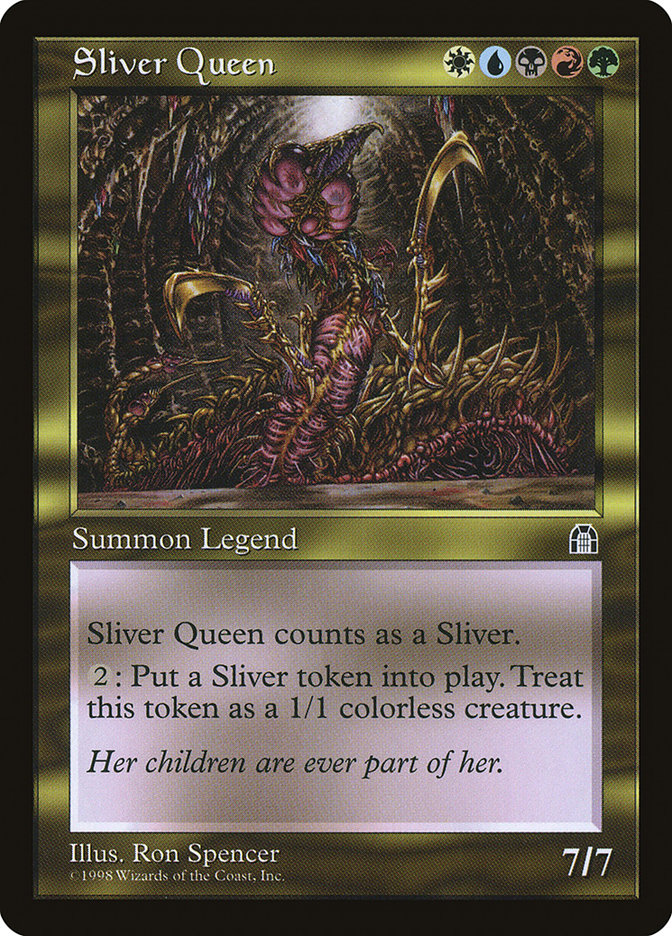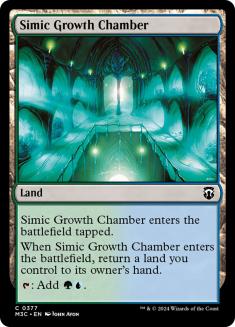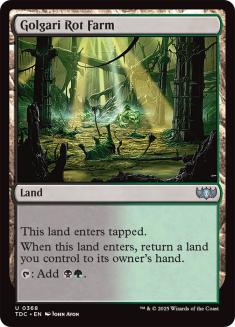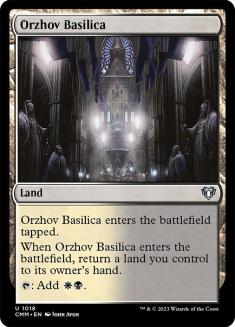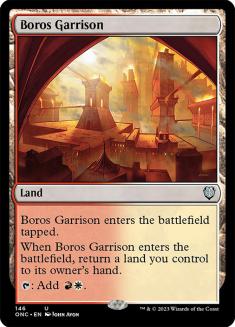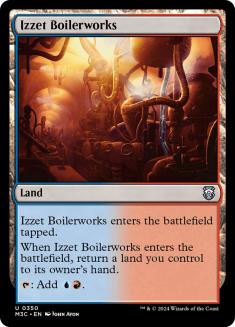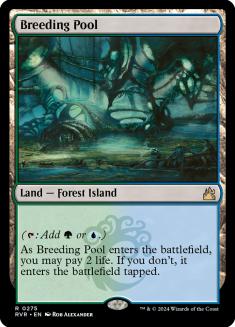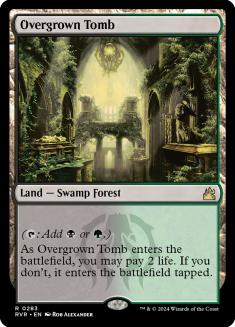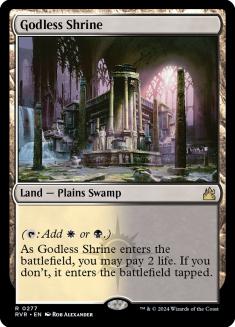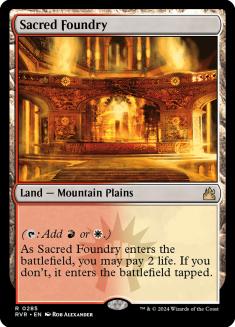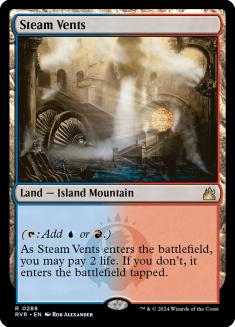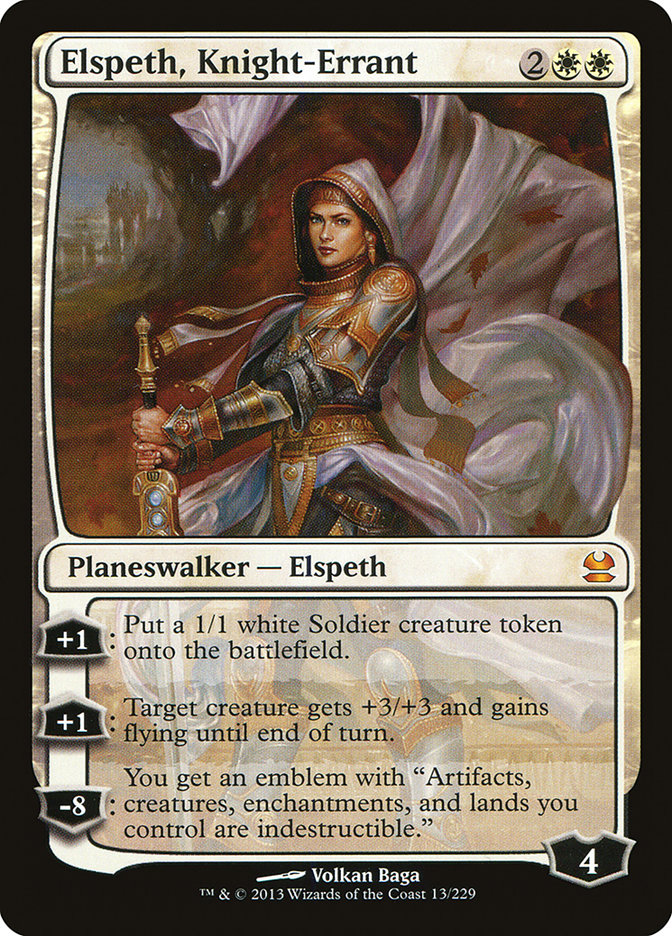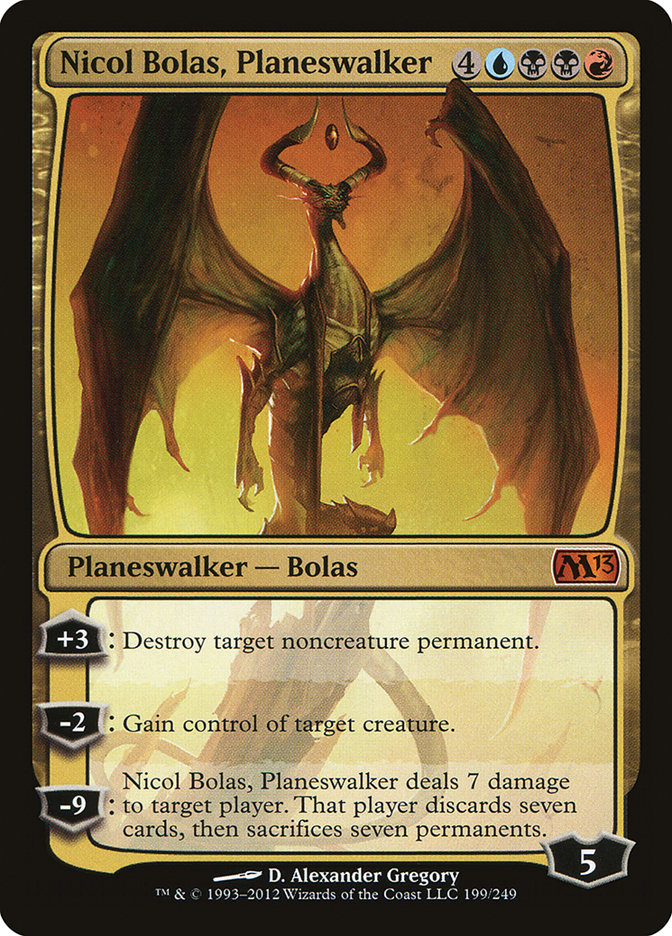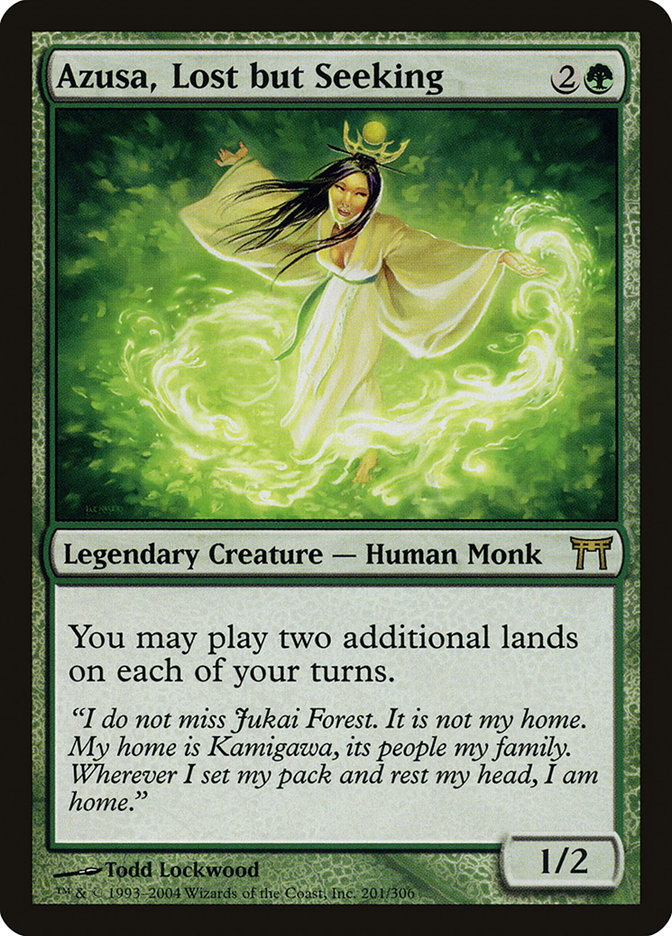I guess this has been coming for a while. I went to my local Commander group last week to have a fun evening slinging cards with my trusty Vish Kal, Blood Arbiter deck, newly rebuilt to use a few recently-printed cards and re-focused on the key themes I saw in the deck, lifegain and persistence. But really, I brought it because my Animar, Soul of Elements deck has gotten downright vicious thanks to the high power (and price) level I’ve let it get to recently.
In trying to keep myself firmly connected to the game over the past year despite the book I’m writing seeking to monopolize as much of my time as possible, I set it up so that I only receive “in kind” payments for my writing. Cash is boring, but store credit means shiny things appear on my doorstep and then jump into decks! When I wasn’t really paying attention, the fact that this “wasn’t real money” crept up on my decision-making process and turned Animar into a monster — one with an absurd price tag to boot.
Creatures (44)
- 1 Sakura-Tribe Elder
- 1 Solemn Simulacrum
- 1 Man-o'-War
- 1 Wood Elves
- 1 Myojin of Seeing Winds
- 1 Godo, Bandit Warlord
- 1 Genesis
- 1 Forgotten Ancient
- 1 Eternal Witness
- 1 Yavimaya Elder
- 1 Great Whale
- 1 Gilded Drake
- 1 Duplicant
- 1 Fierce Empath
- 1 Nantuko Vigilante
- 1 Peregrine Drake
- 1 Flametongue Kavu
- 1 Primordial Sage
- 1 Coiling Oracle
- 1 Loaming Shaman
- 1 Brine Elemental
- 1 Draining Whelk
- 1 Vesuvan Shapeshifter
- 1 Deadwood Treefolk
- 1 Venser, Shaper Savant
- 1 Mulldrifter
- 1 Slithermuse
- 1 Bloom Tender
- 1 Bloodbraid Elf
- 1 Lotus Cobra
- 1 Oracle of Mul Daya
- 1 Kozilek, Butcher of Truth
- 1 Vengevine
- 1 Garruk's Packleader
- 1 Phyrexian Metamorph
- 1 Animar, Soul of Elements
- 1 Edric, Spymaster of Trest
- 1 Craterhoof Behemoth
- 1 Soul of the Harvest
- 1 Maelstrom Wanderer
- 1 Shardless Agent
- 1 Diluvian Primordial
- 1 Prime Speaker Zegana
- 1 Renegade Krasis
Lands (37)
- 3 Forest
- 1 Wooded Foothills
- 1 Gaea's Cradle
- 1 Mountain
- 3 Island
- 1 Volcanic Island
- 1 Tropical Island
- 1 Taiga
- 1 Windswept Heath
- 1 Flooded Strand
- 1 Bloodstained Mire
- 1 Winding Canyons
- 1 Steam Vents
- 1 Stomping Ground
- 1 Breeding Pool
- 1 Llanowar Reborn
- 1 Mosswort Bridge
- 1 Spinerock Knoll
- 1 Fire-Lit Thicket
- 1 Cascade Bluffs
- 1 Flooded Grove
- 1 Rootbound Crag
- 1 Arid Mesa
- 1 Misty Rainforest
- 1 Oran-Rief, the Vastwood
- 1 Scalding Tarn
- 1 Verdant Catacombs
- 1 Command Tower
- 1 Hinterland Harbor
- 1 Sulfur Falls
- 1 Kessig Wolf Run
- 1 Alchemist's Refuge
- 1 Opal Palace
Spells (19)

I built this deck originally on Magic Online for about a hundred tickets back when Zendikar fetch lands were three tickets and your average dual land was seven tickets. And it transformed itself into a $2500 monster when I wasn’t paying attention — the last time I took it out for a spin at the local shop, Twenty Sided Store, I realized that this half-pound brick of cardboard could be turned into a car if I wanted it to. Thinking more along that line was weighty because cars are weighty — half a pound of pretty pictures could weigh a ton and move under its own power if I really wanted it to.
This realization probably had more to do with the lack of sleep than anything else. That weird thought was followed it up as I walked to my train with the thought that it would probably be really awesome to drive around in Animar. Brains are weird sometimes.
The deck routinely attacks the table for lethal around turn five or six even against stiff resistance, and about the only ways left to make it “better” would be to put in the extra $320 or so to upgrade whatever the weakest slots were for the missing fetch land (Polluted Delta) and Mana Drain. And since I’d be spending pretend fun-time money instead of actual dollars, there was no real consideration to put into that: attaining perfection by pushing the price more toward $3,000 instead of doing something else with the proceeds was self-evident. However many of my next articles it took before I decided now was the time to spend for those particular cards didn’t matter, because it was inevitable; it was just going to happen at some vague point in the future.
I suppose that what followed next was also inevitable. I didn’t really have fun with the Vish Kal deck — I’d worked for a few days to build it up into a sleeker and leaner machine, patched in some new card drawing engines so that I wouldn’t regularly face the problem of the deck sputtering out later in the game and having nothing to do, and in two very good games found the deck still sputtered out because as strongly as I’d built up the “life gain as a path to combat damage” vector, it still faced key problems when the individual lifelink creatures were killed early. Since I didn’t have fun, it was time to give up on the deck and go back next week with the razor-honed murder machine again.
And then I decided to stay home instead.
Since then I’ve been facing down the reason why, and it’s time for me to acknowledge I need a power level reset. It wasn’t the price of the deck compared to the size of the deck box, because Legacy decks beat that by a solid 25 percent on top of this admittedly absurd amount. It was the realization that I had become utterly unbounded from any restriction and without these boundaries I had shaken loose any interest in interaction.
The problem was exactly the same as I faced when I created “The Worst Thing You Can Still Do To People,” and I couldn’t even rationalize playing the deck as “I am trying to publicize a problem and get Ad Nauseam banned.” I spend a lot of time here in this column advocating basically for “Don’t Be That Guy,” but here I was becoming That Guy. Little wonder then that I decided to stay home instead — my subconscious was far ahead of the rest of my brain in realizing my priorities were far out of whack and that I had a problem that required addressing.
So I took the ridiculously expensive deck apart and have begun the process of selling my excess Magic cards — not because I want a car, though I do miss having one at least a little, but because as long as that expensive lump of cardboard was hanging around the temptation to believe the problem was not as big as I was making it out to be would remain very strong. Even if I traded off all of the cards for other things, the aggregate problem of having literally anything imaginable at my fingertips would lead me to the same high-powered rumblefest that was weighing me down and killing the fun.
Plus I loathe trading — having to commit that much time to actually knowing the value of things is too much brain space and energy for me to stay on top of, space that for the past year I’ve put into research for my book instead and been happier for it.The sweet temptations whispered in my ear — surely you won’t get rid of your Mana Crypt even if you get rid of everything else, right? That’s the best hundred dollars you could possibly invest in Commander, right?
It was time for a change, but the thought of a new deck that was rumbling around in my brain wasn’t actually taking me anywhere interesting. I was thinking of a U/R deck with a strong artifact theme based on wanting to put Goblin Welder to work in Commander and see what happened — it’s not like people will really care if you’re just welding Ichor Wellspring in and out of play, right? The motivation was really to try to have fun with Mizzium Transreliquat, and I got that out of my system the last time when it seemed likely that my thoughts were not going to actually coalesce into a fun new deck of my choice.
Worse yet, the temptation of going wacky and saying “Tibor and Lumia can’t be a scary Commander, right?” but holding on to that Volcanic Island and all of the other expensive things was taking me in the wrong direction. As far as I was concerned, I needed to do a massive deleveraging and stick myself back into what most of you would consider “the normal Commander zone” instead of floating in the economic stratosphere doing whatever the heck I damn well felt like and pretending there were no consequences. The first and most important consequence was I was finding it impossible to have fun.
The budgetary restriction wouldn’t be a necessity, but it did clarify a lot. I’ve had a deck I’ve been wanting to build for about a year now, but the stumbling block was coming down at the sheer expense of getting all of the Revised dual lands in order to truly jam a five-color commander on a max-powered fetch-dual mana base. Yes, I already had at least one copy of each fetch land save for Polluted Delta (and four of each of the Modern-playable ones, as I’m trying to go pretty deep in that format), but the other seven dual lands were a critical stumbling block.
I had a Tundra because I’ve been playing U/W Miracles in Legacy (and playing it abysmally, thank you very much!) and I was seriously considering a Scrubland anyway to bring the Vish Kal deck up to fighting power. But I’d need five more dual lands besides after that, including the most expensive one of all in Underground Sea.
But that perspective was a ridiculous reason not to chase my bliss — I wanted to play that deck, and there was no reason I needed to have a few thousand dollars just to cover the manabase. The idea of letting go instead of chasing the Joneses would let me play that deck today with minimal investment if I was willing to just reconsider my priorities, and that meant I could finally explore my idea now instead of holding it off for some perfect future where I’d invested another thousand dollars or so “attaining perfection.”
The Perfect Is The Enemy Of The Good
Let me tell you about my new deck. We’ll look at “the cards in the deck” soon enough, but first I want to tell you about what I want it to do, what it is that I find so curious and interesting that I have decided I want to pursue it. After all, we play Commander for the freedom it allows us to explore an effectively unlimited amount of creative space — I’d honed my last weapon to functional perfection, but perfection was boring. I want to enjoy what I find compelling, not merely what I’ve found is “the best.”
My lady fair.
The first assumption of course is that this is a Sliver deck. It’s not. Sliver Queen would be the worst Sliver commander available; Sliver Legion pumps everyone to ridiculous levels as if your commander were Coat of Arms, while Sliver Overlord is the super tutor Sliver commander we all fear as a Sliver-based combo deck. Sliver Queen just makes Sliver tokens which aren’t even good without a critical mass of other Sliver things going on, so I’m looking to play her for that token-making effect. That the tokens are Slivers isn’t of importance — they could be Kithkin or Kobolds or Krakens for all that I care.
I want to play all five colors, so I have a limited number of choices, and Sliver Queen is the best one for building defensively. She makes tokens at an attractive rate and thus can provide us with blockers as-needed for two mana per chump block.
Blocking effectively is critical because I want to build a planeswalker-based deck; while the usual avenue for this is to go tutor-heavy and make sure you have half a dozen or so effective copies of Doubling Season, I don’t want to go that route. I have no problem playing tutors, but I am trying to capitalize off of my ‘Walkers as planeswalkers instead of as two-card combos for building awesome sorceries. While almost all of the planeswalkers I play will be able to ultimate off of a Doubling Season and I am of course playing Doubling Season, that’s not our focus — it’s a minor chord, not a major riff. We can “get there” by playing defensively and blocking with the Queen and her minions.
I am taking the control role, so I am going to need plentiful removal and card advantage effects and just space-wise that means I am not going to have a whole lot of creatures. Most of my decks tend to be about one-third creatures, even my controlling decks, but since we have an extremely efficient commander that can populate the board without having to spend extra cards to do so, we’re going to play about half of that number. Sliver Queen also serves as an excellent way to spend unused mana, meaning we can play at instant speed (and thus a little bit more counter-heavy if we want to be) with all upsides for saving our mana. Even if we don’t end up wanting to respond to anything, we still have a worthwhile way to spend that mana and advance our board.
Huge Tracts Of Land
One of the key appeals (for me) to building this planeswalker-themed deck as a five-color deck instead of a three-color one, such as you might expect to see with Angus Mackenzie or another similarly defensively themed commander, is access to bounce lands to develop our mana. People don’t appreciate the bounce lands enough in Commander — last week’s Commander Versus (the first to go four player — congrats to David McDarby on his vision coming to fruition!) included Chris VanMeter getting his Simic Growth Chamber killed and everyone at the table lamenting how the bounce lands are generally bad in Commander, an assessment I flat-out disagree with.
Bounce lands are free extra mana since they’re a lot like drawing two lands off of one card, and there is nothing I love more in this format than Winding Canyons than getting extra mana without having to spend cards to do it. And much of the reason I like three-color decks is that you get to play three good “Karoo” plus Temple of the False God so you can expect to get a free mana bump a reasonable amount of the time — getting something for nothing always feels great.
But bounce lands aren’t free, and playing a lot of them obviously comes with risks. But if you’re playing additional cards that work to cut back the negative impacts everyone worries about, you can build around the fear of blowouts and get a lot of power for your effort. I’ve been thinking about trying to play a five-color commander with all ten bounce lands for a while now; it’s time to finally build it.
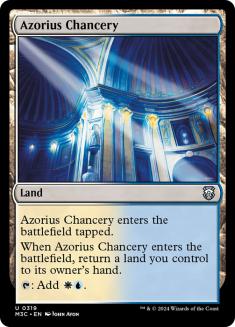
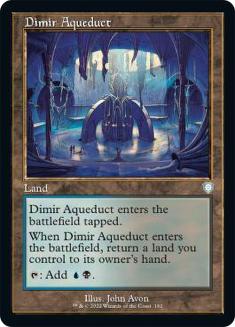
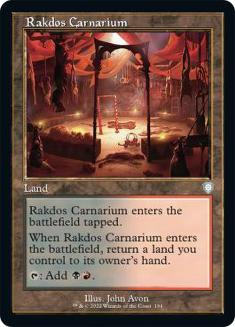
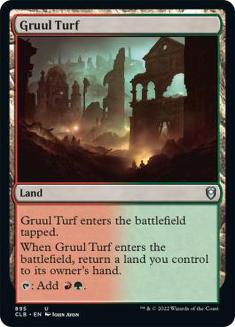
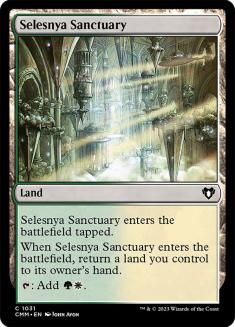
These extra mana lands have some requirements — you need to draw a “real” land with them, so I’m going to play more lands than I usually do. I tend to start at 37. To make sure we draw keepable hands that don’t get completely gummed up in the early turns, we’re going to favor some cheaper cards and enablers that help us hit more land drops… and we’re also going to play 39 lands. That should give us a ton of mana at our disposal without really needing to build in any ramp effects; most decks have the ability to naturally tap for about 37 mana out of their manabase, but we’ll be able to tap for way more than that.
Each bounce land is practically worth another card if we play things right, so we don’t need to play cards like Mirari’s Wake in order to access more mana — those cards feel obnoxious to me anyway. We’re going to play a slow and patient game and just get there eventually off of the strength of our mana base.
But there’s another cycle of lands that works really well with this plan since we’re already going to be playing a deck that aims to work more at instant speed than on its own turn, likes a lot of mana, and will even have a counter-doubling/proliferation subtheme. They’re another class of lands that I really like to play in Commander but usually only get to play one or two of in a three-color deck. Drawing them is great but not consistent, because you aren’t playing enough of them to expect to see one with any regularity over the course of a normal game. But a five-color deck can afford to play all five, so I am.
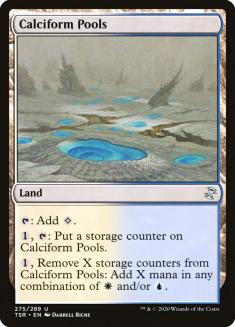
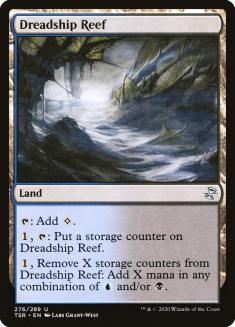
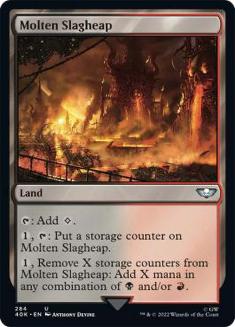
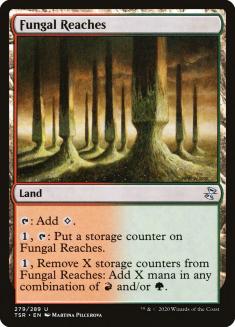
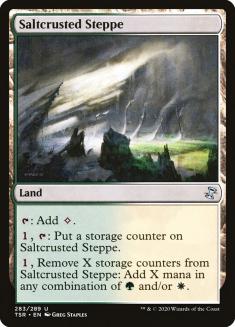
After that, we really just need to fill in more lands that help us hit our colors. We’re going to play a fairly-even spread of lands rather than bias toward any particular color and use our land-searching effects to make sure we hit the right colors based on our draws. We’re generally going to want extra blue and extra white but need to hit all five colors on time to play Sliver Queen, so we just need pure color density from our other cycles of lands. These five start to push us to the point where we’re worrying about all of our lands coming into play tapped and gumming up our draws, but they’re the best they are at what they do so they fit the bill exactly.
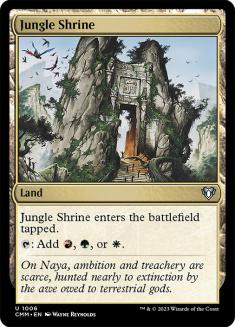
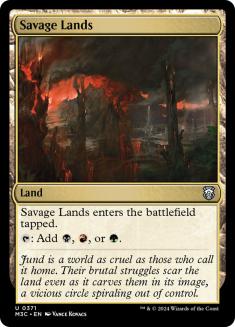
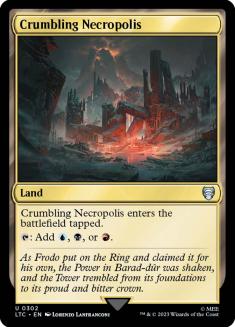
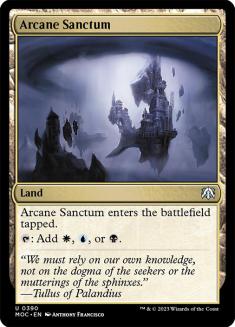
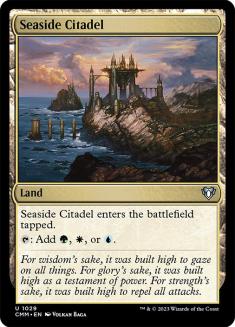
We could play a more selective game if we really wanted to and play the Mirage cycle of fetch lands — we aren’t going to be playing the uber fetch-dual mana base, as we’re cutting the overall expense of the deck away from Flooded Strand into Underground Sea territory, but with our next cycle of cards, it’s worthy of consideration since that way all five could find a green source and cast a green fixer instead of just three out of the five providing green mana naturally. Overall, it’s a bit up in the air still to me, and that’s a design note I leave to myself for future consideration.
I’m building the first draft to play with, not necessarily the “optimized” list; I expect the deck to both streamline and grow further as I put it through its paces in my local playgroup. Notes for later with suggested changes are still fine for now, but it’s worth exploring where the tensions are, as the Shards of Alara lands are very strong but the Mirage fetch lands would still work excellently with our next ten lands:
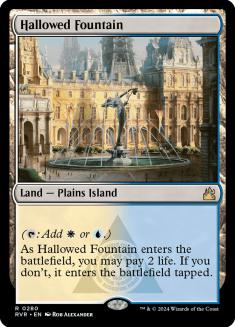
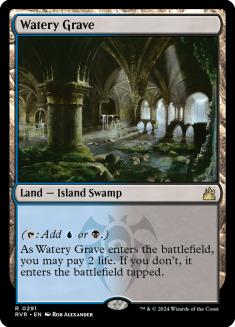
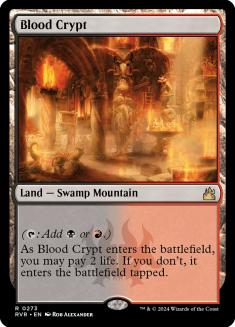
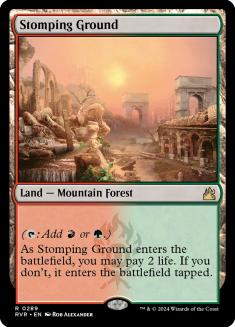
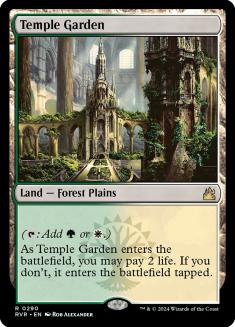
This covers thirty of our 39 lands, and we don’t even have any basics (despite the fact that I know we want at least some since part of our spell and creature base will include some land-fetching effects). So the next five slots get penciled in as one of each basic land, leaving us four slots. One of those three is Command Tower — it’s a zero-drawback five-color land in our deck and thus obviously ideal. Krosan Verge is too good to pass up, as any deck that can play it and get two lands out of it probably should do so.
And since I want a dash of utility in my lands as well, the last two slots are going to go to lands with special abilities that advance my overall game plan, which in this case are Alchemist’s Refuge and Vault of the Archangel. The Refuge is Winding Canyons on steroids and able to bring any card in our deck online with the “only spend your mana on other peoples’ turns” plan — and Vault of the Archangel is able to provide some cheap life gain off of a well-developed board but is mostly included for its ability to grant deathtouch to our Sliver tokens. That particular keyword will make them considerably more effective deterrents to opposing attacks, and thus far better able to protect our planeswalkers.
The Heart Of The Cards
This many bounce lands comes with some drawbacks, and we’ll need to address those soon. But the beating heart of the deck is its planeswalkers. We’re going to try to use them to gain a consistent advantage, and there is also a certain allure to the idea that any planeswalker may be a really awesome sorcery if we have Doubling Season out, so we’re going to (lightly) bias in favor of planeswalkers that can ultimate immediately if we have Doubling Season.
Venser, the Sojourner – The only planeswalker we’re playing that doesn’t fit the “ultimate rule” (which is more of a guideline anyway), it’s worthy of inclusion because if you do get his ultimate off, it’s a game changer of an emblem to attain. We’re also going to have a fair number of cards that this can beneficially reset, so while it is our “weakest” walker, it is still going to be consistently strong in our deck.
Sorin, Lord of Innistrad – We’re a token-based deck at least in part thanks to our commander and our desire to have her in play with fair regularity, so the Sorin emblem is going to be particularly strong in our deck and thus even without anything else working out, this walker will do a lot for a four-mana card. With proliferate effects or something else to reset its loyalty (hi Venser!), it can even create an emblem each turn, making Sliver Queen more and more dangerous, and the plus effect is still a good one, so increasing loyalty the old-fashioned way will be beneficial and the Ultimate is very strong.
Elspeth, Knight-Errant – Another incredibly strong ultimate comes to us from a planeswalker who has earned a lot of play in Commander since she was printed in Shards of Alara. There is a lot to love about the idea of playing Doubling Season and then getting to make our entire board permanently indestructible, but things won’t always play out that way so we should plan on having to do some work here. Like Sorin, Elspeth’s +1 ability to put a token creature into play isn’t what we’re hoping to do much of the time but it doesn’t stink either, though this one’s not special compared to the rest of our tokens since it doesn’t have lifelink.
The other +1 ability though is quite special indeed — commander damage is a very real thing when you have an efficient high-powered commander like our five-mana 7/7, and Elspeth’s ability to throw Sliver Queen “to the air!” Angelic Blessing-style can really shorten games in a hurry if that control game isn’t really working out. She buffs up the non-control side of the deck considerably because let’s face it — sometimes the best way to “control” a game is to attack the dirty combo player mercilessly until they are dead. Then the remaining three players can finish a “real” game from there.
Garruk, Primal Hunter – Another token maker, Garruk also has a mini ultimate that is practically a personal Wheel of Fortune since Sliver Queen starts as a 7/7 for the same price as Garruk. Getting a 3/3 for a +1 instead of a -1 is a dramatic difference since you can keep it up forever and build toward something, and the actual ultimate of -6, make a pile of Wurms can also make a bunch of opponents real dead in a hurry. But that we get to play a walker that makes big critters to defend itself with and can fit into our card draw suite is very important since it will tend to recruit more friends from the top of the deck to help take over the game.
Garruk Wildspeaker – The token making is a minus, not a plus, but still this is a Garruk that is prepared to defend itself right off the bat. And the actual plus ability of untapping two lands is very potent in our deck full of Ravnica bounce lands, since Garruk may actually just come down for free on your average turn and have an Overrun’s worth of loyalty ready to go on the next turn. This Garruk is still one of the most dangerous planeswalkers there is in Commander for exactly this reason, and we’re well-poised to optimize it thanks to both the bounce lands we play in large quantity and the token-making aspect of our chosen Commander. It’s a boring inclusion, sure, but it’s still an incredibly strong card that we’re using it at its best.
Elspeth Tirel – Since the token making here is a significant minus ability compared to the easy plus on Elspeth, Knight-Errant, we’re not using this Elspeth for exactly that purpose. Here the +1 ability is a bunch of life, how much depending exactly on how prodigiously our Queen has been populating our side of the board with her token brood, and the ultimate ability is a potent removal spell that we can access surprisingly quickly. Since it’s just one more than her starting loyalty, any proliferate card will help us get there, not “just” Doubling Season, so even a lowly Contagion Clasp can help turn this into a sweeper spell on the spot if you need it to be one.
Liliana Vess – I don’t love tutoring in this deck and have tried to keep it pretty light for a reason, but Liliana’s balance of powerful -2 and amazing ultimate ability (which we may even be able to access immediately with Doubling Season) more than make up for the fact that her +1 ability is rather lackluster in this format. I’ve used her to good effect in a control deck before, whittling down opposing cards in hand and threatening a Rise of the Dark Realms off of her ultimate, but the real power will come from getting access to that ultimate unfairly or the fact that she can set up our next couple of draws.
Jace, Architect of Thought – Speaking of mega ultimates, Jace’s is deceptive until you play the four best cards in each players’ decks one right after the other for an overwhelming advantage. The +1 ability will not defend us nearly as well in this format as it does in Standard, though there are certainly token decks this will dissuade from attacking us and point at opponents instead, but this is another strong walker we can consider as part of our desired card draw suite as well as a planeswalker. Jace’s -2 is either going to draw you two mid-strength cards or serve as a three-card Impulse, and Jace will be able to keep this up for a surprisingly long time around the rest of the cards we’re playing.
Tamiyo, the Moon Sage – Her -2 ability is even stronger than Jace’s card draw ability, as it can potentially draw a whole lot of cards all at once thanks to the big boards our commander can build up. The +1 doesn’t do that much at all here in this format; it’s probably best served constraining a land like Cabal Coffers more than anything else. But if we’re able to fire off her ultimate somehow, just like Elspeth’s it is an absolute game-changer. Our best walkers all generate emblems, and it’s really hard to overcome Tamiyo’s as long as we have any action at all in hand to go with it.
Nicol Bolas, Planeswalker – We’re going to skip the “don’t” and go right to “be evil.” Nicol Bolas, Planeswalker has a heck of an ultimate to fire off, as it should effectively wipe a player’s hand and force them to severely reset their board, but the impossibility of beating Nicol Bolas in a fair fight is the real reason we’re playing him besides “just because we could.”
+3 loyalty to kill any noncreature permanent is a massive ability to try and dig yourself out from under, so just Bolas plus anything to defend it with should turn the board in your favor over just a few turns, and then there’s the other half of the “mundane” abilities, gaining permanent control of any creature for just two loyalty a turn. Between the board-suppression effect gaining loyalty and the creature-stealing effect spending it away, it’s really hard to escape Nicol Bolas’ clutches if he starts from a reasonably neutral board state.
Building The Deck’s Skeleton
We want cards that supplement our planeswalkers. We need cards that control the board, interacting with enemy permanents and nullifying them or otherwise removing them from play turn after turn. And more important than that, we want cards that help turn our supposed mana fragility that comes from playing a full ten bounce lands into a strength instead as well as cards that help fix our mana overall since we have a five-color mana base that is entirely symmetrical and will need cards that can help find any color of mana we’re missing, not just for whatever spells we’ve drawn but in order to play our commander early on in the game. We really want to leverage the fact that Sliver Queen costs just five mana for a board-controlling 7/7, so we need some support cards to make sure that happens on time.
We’ll start with the mana, which leads me to play a few cards I’ve actually never willingly included in my decks before, and then hit a steady stream of favorites and general role-players that will help make sure everything works out all right.
I tend to stay away from both of these cards, not really wanting to delve into the unfair-feeling “all ramp” strategy that green decks can take if they want to. You can go further down this route if you want to — Exploration, Budoka Gardener, Sakura-Tribe Scout, Walking Atlas and others allow you to play further in this space if you really want to. I picked both of these because turn after turn they allow more than one additional land played per turn, which will really help turn a bounce-land-heavy draw into a lot of mana in play very quickly if we want to.
It’s because of this repeating effect that I chose these and not Summer Bloom, although that card might also be very strong in this deck. Normally I avoid these cards — in fact, I didn’t own them, and had to hunt them down specifically for this deck at the same time I was looking to get rid of my expensive things — but the unique aspects of this deck and the potential strengths that come from using them to leverage a bounce-land-heavy mana base saw me getting over my biases and putting good cards to work.
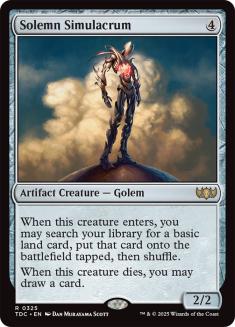
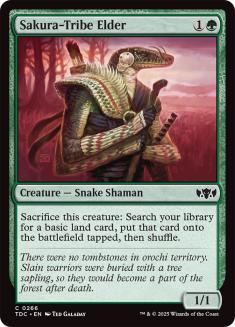
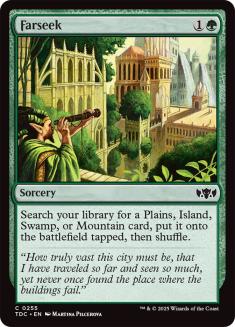
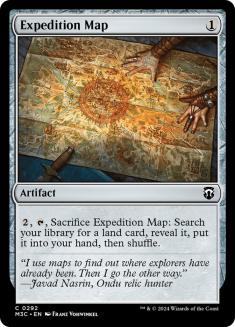
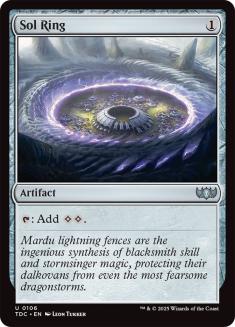
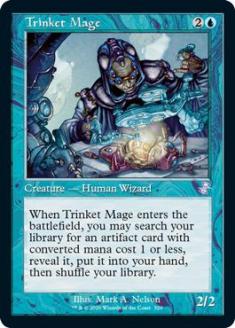

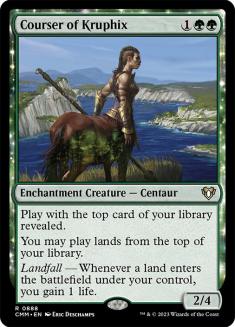
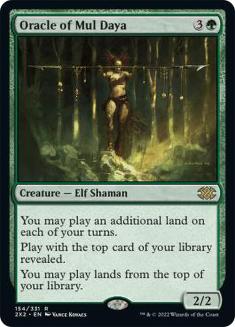
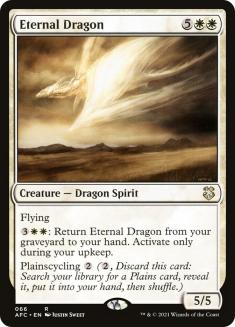
This is a fair number of cards to put to work “just” on building up my mana base further, but many of them include an aspect of card advantage as well that really lets me put them to work in the later stages of the game, not just the early ones. Eternal Dragon is strong for fixing my mana without requiring any colored mana up front but is also a durable threat in the late game, while Trinket Mage has other targets that can let it go crazy and Expedition Map lets me get Alchemist’s Refuge, which will turn our game plan on its ear by allowing us to play planeswalkers at the end of an opponent’s turn, proliferate, untap, and then proliferate again if we want to, maybe getting to fire off an ultimate that we wouldn’t get to if we gave three opponents the option of attacking (and thus spending all of our efforts on its defense instead).
The Oracle and Courser both let us draw action instead of lands by playing our lands off the top of our deck, and there is no such thing as a bad time to Explore. Early or late, it’s a new card off the top of your deck whether you can use the extra land drop or not.
Because we have a mix of card advantage built into most of these cards, whether it is obvious like Solemn Simulacrum’s “draw a card” trigger or implied in things not yet seen (such as Trinket Mage’s invisible trinket targets), we’re able to play a good number of support cards that help our mana without it really affecting our ability to draw a solid mix of action cards later on. We don’t want to ramp this hard just to draw more ramp cards, right? That’s the critical weakness of ramp style decks — running out of things to do — and all of these were chosen specifically because they either help with that or are so darn cheap at what they do that we can’t really argue against them.
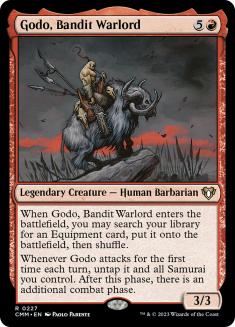
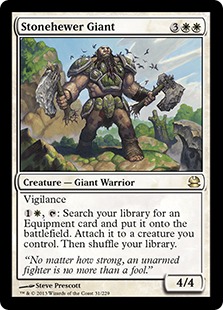
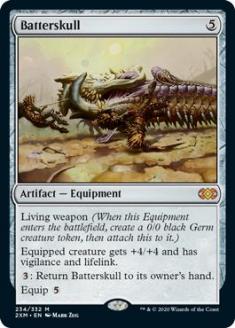
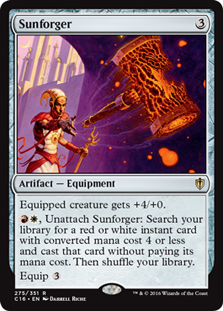
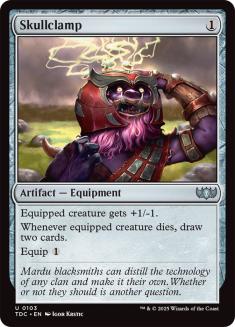
While I may not have room for a lot of Sunforger targets — I’ve currently found just four slots for cards that it works with — I like it nonetheless as something that makes these other cards able to work a little bit harder, and you only really need to get one or two spells out of it before it’s really done its job anyway. No one lets it live forever, and you don’t need to plan out what your seventh through tenth Sunforger targets are anyway, so having just a limited number of slots means that as long as those cards are meeting common needs and reasonably diversified, we’ll be happy with it.
Skullclamp is the obvious high-power card here, as it combines fantastically with our token-generating commander and can be found by the most number of cards (see also our Trinket Mage from above), and Batterskull is the strongest (though not necessarily offensively so) life-gain-related equipment we can play that meshes with our overarching plan. Behemoth Sledge or Loxodon Warhammer could perform as adequately while also giving our commander trample, helping to enable commander damage as a route to victory more frequently, but I prefer the resilience and built-in body of Batterskull as my life gain Equipment card of choice.
I could have built further down this line of thinking — apparently I have somehow gotten myself not merely a playset of Stoneforge Mystic for my Legacy U/W Miracles deck but also a fifth copy so I can be lazy and play Commander without having to find my Legacy deck and slot one of them out — but I don’t find this avenue of consideration interesting enough to mine further. Stoneforge is more abstractly powerful (“costs two” is a superpower in single-player Constructed next to five- and six-drops) but far less useful against the big cards in this format than either Godo or Stonehewer will be.
If I wanted as many Equipment tutor cards as I had Equipment, I’d consider it, but this was only ever intended to be a minor theme except for “Skullclamp is awesome with Sliver Queen so you should really try to find it!” Thus the abstractly powerful Legacy staple is not good enough to play here. After all, we have all the mana and time we could want, and Stonehewer can attach a Sunforger out of our deck at instant speed, allowing us to get a free spell without it being immediately obvious, while Stoneforge does not do anything like that because it is a Squire.
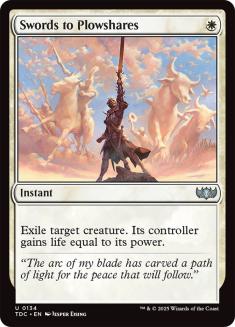
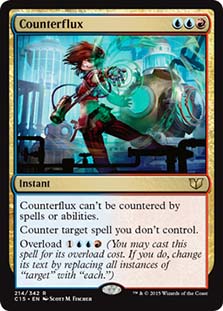
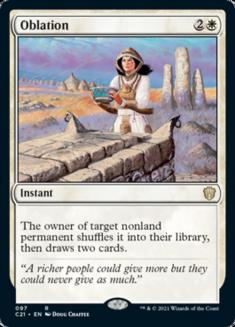
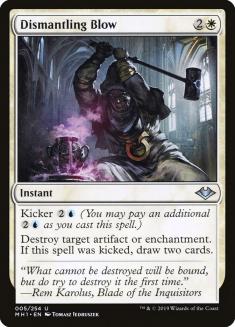
This is our Sunforger suite and also covers our basic instant speed pinpoint removal while we’re at it. I like a few cheap instants to answer problems anyway, and the one-mana Swords to Plowshares remains the most efficient there is at what it does even after twenty years of Magic. Counterflux is our nod to wanting a counterspell and has the advantage of winning a counter war without much in the way of argument, while Oblation can answer any nonland permanent type without really caring what problem needs to be solved — if it’s not a land and it can be targeted, it’s gone.
Dismantling Blow is there to cover our card draw needs as well as serve as a cheap removal spell for a problem class of permanents, as you’re still allowed to pay the kicker cost off of Sunforger and thus in the bland middle turns of a game, you can use Sunforger to hit whatever artifact or enchantment is lying around and get two fresh cards while you’re at it. We could play more of these and thus have more options, but the overall balance of the deck would start to wander off — yes, I’d like a Path to Exile and Dawn Charm as well to cover a versatile range of options, but we can’t fit everything and have all of the balances I’m hoping to make with the deck work out right. Those are luxury additions; these are basic requirements.
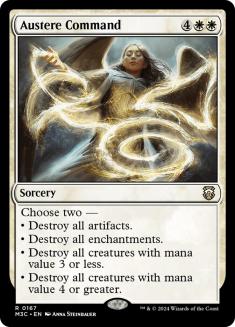
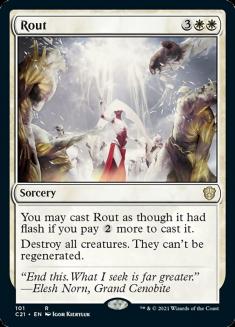
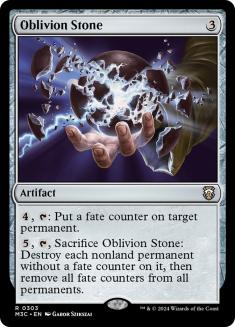
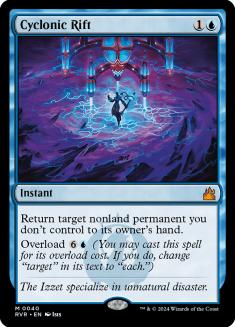
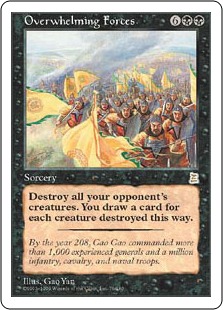
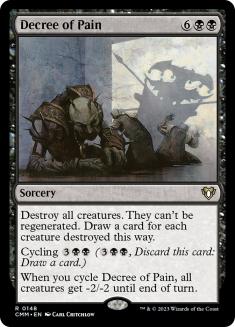
I’m not going to lie — keeping the quite expensive Overwhelming Forces while I’m divesting myself of all the expensive weird cards like Capture of Jingzhou and Temporal Manipulation that I’ve picked up just to play in Commander feels off, but unlike those other cards, Overwhelming Forces was purchased in Tokyo while on a trip there with my girlfriend and thus has a stay of execution despite the price tag as I shuck off unneeded expensive things. (Our trip included visiting local gaming shops because The Girl is awesome and wanted to go looking for hard to find videogames as well as let me ogle Magic cards, so keeping a memento is a good enough reason to hold on to it since it was the only thing I bought while we went wandering, shopping, and visiting every cat cafe we could find.)
The choice of sweepers favors a balance of broad utility (Austere Command), card advantage (Decree of Pain and Overwhelming Forces), and the obvious benefits of being able to generate my sweeper effect at instant speed (Oblivion Stone, Rout, Cyclonic Rift). We don’t really need more sweepers than this since after this we see clear diminishing returns on these utility aspects — if we still want it to play at instant speed, it’s going to come with limitations (like Starstorm) or not dodge permanent types we care about (Fated Intervention) or worse yet just blow up everything on our side of the board without much in the way of discrimination for the parts of our board we liked and wanted to keep (even though Nevinyrral’s Disk doesn’t kill planeswalkers, we kind of want to keep the rest of our stuff too sometimes).
Meat & Muscle
We’ve got the basic shape of the deck so far, and now we need to put some flesh on that skeleton in order to make it work. We’ve got our bits of ramp and supporting control cards, enough to be confident that as long as we draw a reasonable balance of cards over the course of a game that we’ll be able to play a good game of Magic and do powerful things. Now it’s time to riff on those major chords and build them into a cohesive whole by adding whatever support is still needed to suit our overarching plan.
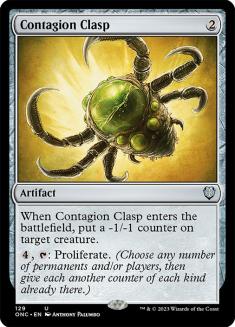
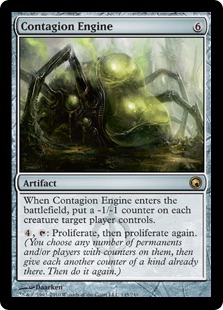
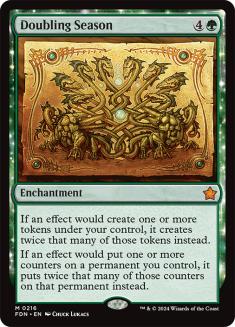
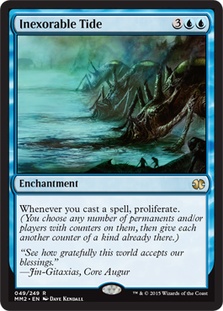
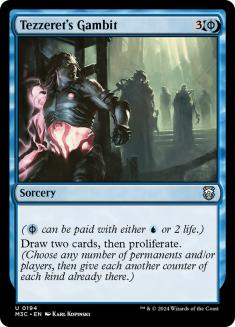
Doubling Season is the real hero here since we make double Sliver tokens and also just get planeswalkers we can immediately ultimate (if we want to) without even so much as a trigger going on the stack in order to prevent us from playing walkers as sorceries if that is our goal for the turn. The proliferate aspect of the other four cards doesn’t help with tokens or work if we can’t yield priority before trying to get the effect, but there is a certain power that comes with using our proliferate cards turn after turn and even potentially getting more mana for a later turn while we’re at it thanks to the cycle of Time Spiral charge lands.
Tezzeret’s Gambit doesn’t exactly see a lot of play in this format, and in fact this started out as a Mulldrifter before I dug into my Big Box Of Commander Cards and saw the Gambit staring at me asking to finally be put to work somewhere, but the understated subtlety of the effect doesn’t speak as loudly in favor of the card as it should. If you can take advantage of the proliferate at all, it’s going to be worth almost three cards for three mana as part of your card draw, and the better your board is, the more virtual cards’ worth of advantage that bonus proliferate tacked on is going to be worth.
It’s also worth noting that this many proliferate cards necessitates us not having any way to give our opponents a poison counter ever because that is just no fun and not what we’re trying to do.
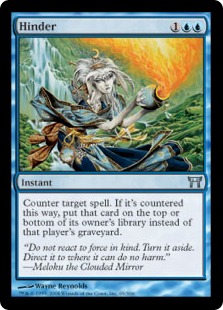
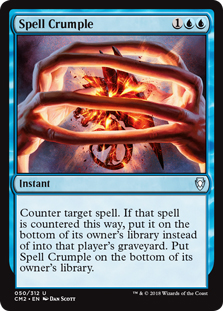
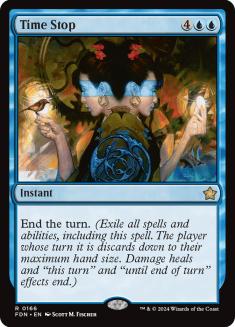
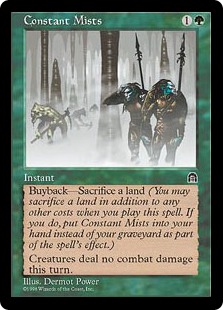
I think of this as the “supplemental control” suite; we don’t really want to commit ourselves that heavily to playing countermagic since it is ultimately just a one-for-one exchange with just one player when you have three opponents, not one, but I do want to be able to lock down problem commanders and otherwise have a counterspell in hand in the later stages of the game, so I do want at least a few. Hinder and Spell Crumple answer commanders best, while Time Stop answers pretty much anything without split second and can fix all sorts of unexpected dastardly problems or just be a Fog to survive a lethal turn.
And Constant Mists is my “counterspell for the attack phase.” I consider it to be secretly one of the most powerful cards in the format, as we see a lot of creature combat in Commander. Constant Mists may cost a fair bit to keep up, but we have bounce lands that make sure we can pay that cost without crippling our mana base and cards like Oracle of Mul Daya to ensure we have fuel to keep it running. Since it is a buyback card with no targets, you really need to have dedicated discard or a counterspell to stop it, which plenty of decks lack straight up since only blue or black can effectively stop it.

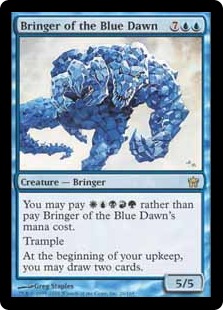
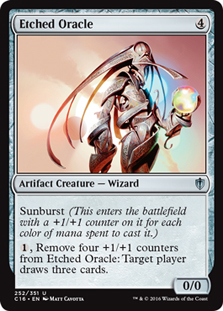


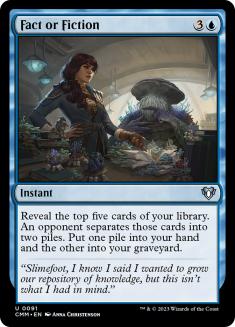
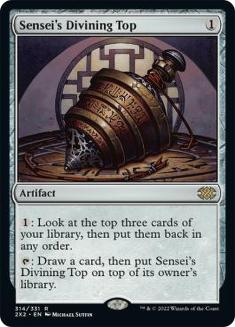
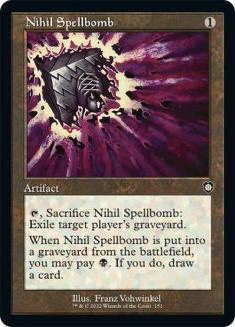
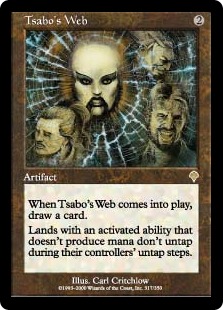
This rounds out our card advantage suite; I like playing with at least one Eldrazi in my deck in order to harvest the card recursion aspects and because sometimes people will try to mill you out. Playing a Kozilek, Butcher of Truth to this effect is relatively painless because this is a big mana format where a fatty that draws you four cards is not unwelcome.
Bringer of the Blue Dawn is just too many free cards to turn down, though it was another card I’d left off of my “things I will ever let myself play” list and thus had to hunt down specifically for this deck because I didn’t own a copy, while the two Etched creatures enjoy the sweet benefits of me already building a five-color deck and having proliferate as part of a subtheme so that I can potentially use their card draw abilities multiple times. I’d love Etched Oracle in this deck just as a four-mana 4/4 that could draw me three cards, but the proliferate cards all have the ability to push him to 5/5 and above, letting me sacrifice four counters for three cards and live to tell the tale.
Etched Monstrosity has problems with Doubling Season, but the three proliferate cards that are based off of permanents that stay in play can all put a sixth -1/-1 counter on it before spending five to draw cards, and even without such a trick as that, you get to keep a 10/10 monster instead of sacrificing itself (as an Etched Oracle would without anything to help enhance it). I include Demonic Tutor here as “card advantage” for lack of a better label because whatever the “right” card is going to be, it’s very likely going to net me some number of cards’ worth of value for having plucked it out of my deck. We’ve added enough card advantage avenues that we’re sure to profit from picking the best of anything.
Sensei’s Divining Top is boring, but we have cards that care about the top card of our deck, so we’ll play it even though we don’t have many shuffle effects and thus our Top is comparatively low powered thanks to the fact that we’re playing cheap bounce lands instead of expensive fetch lands. Fact or Fiction is obviously strong card advantage, though I did consider Steam Augury just to get another Sunforger target. When I actually cast a Steam Augury, I quickly got over that idea.
Nihil Spellbomb is my nod to the fact that graveyard-based strategies are a thing that is real and thus deserving of attention. I wanted a cheap cantrip so that it was card neutral (and thus otherwise invisible when I didn’t want it), and I wanted it to work with as many other cards in the deck as possible so I could hunt it down when needed, which meant I wanted it to be findable by Trinket Mage, an Equipment card, or a white or red instant costing four or less so that I could find it with Sunforger. This met enough needs while being otherwise invisible, unlike something like Purify the Grave or Honor the Fallen, which I might have more ways to access but basically suck if you draw them and don’t have a high-powered need for graveyard hate right now.
And Tsabo’s Web is just me playing to the advantages of my mana base — only the charge lands and my two utility lands, Vault of the Archangel and Alchemist’s Refuge, won’t untap with a Web in play, while other players with much fancier mana bases may be considerably impacted for trying to get too jiggy with it. It’s another card I’ve been wanting to try, and I’m happy to give it a home here — after all, I can still charge my lands with proliferate and get a later benefit, and if I’m stuck using my two utility lands as if they were spells, they will be spells I will be able to easily reset with any of my ten bounce lands, so I can still circumvent the technical drawbacks of Tsabo’s Web on my own mana base. (Or just draw the card and cast my Dismantling Blow with kicker at it like we used to do in the good old days.)
By my count, that leaves me with just five cards left to finish off the deck, and I still want some more ways to close out a game and otherwise durable things to grind out an advantage with. And we still have zero Sliver cards despite the fact that at least some of them might be good to incidentally add thanks to the fact that Sliver Queen dumps out tokens like it’s nobody’s business.
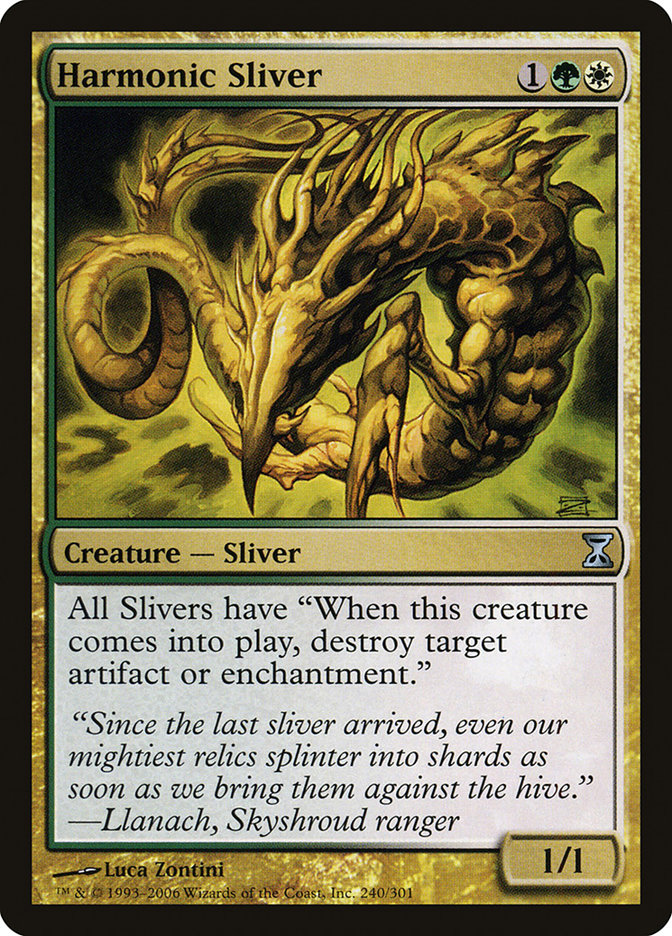
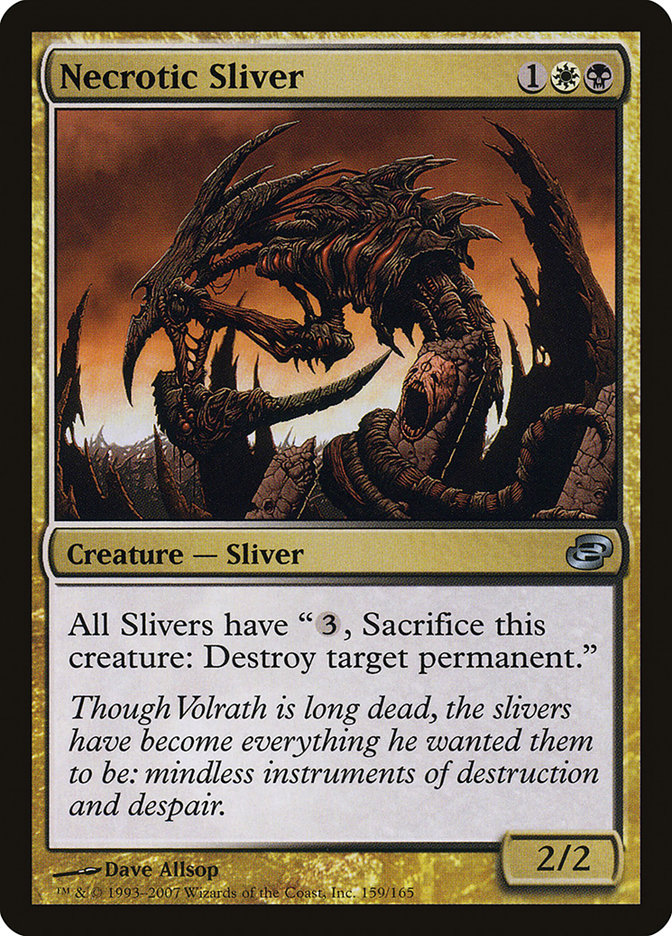
Harmonic Sliver – We’re trying to control the board but don’t necessarily want to spend cards in our hand one for one to remove opposing cards in play. That leads to us falling very far behind, after all, because there are three of them for every one of us. We’re already strong at removing creatures from play with our sweepers or otherwise ignoring them thanks to Sliver Queen’s prodigious abilities to create blockers, but what if Sliver Queen’s bountiful ability to make tokens could control other things as well?
Looking at the Slivers that have comes into play abilities made it quite apparent that Harmonic Sliver could be used to suppress a fairly large number of artifacts and enchantments, the latter of which at least tends to be both the most powerful card type once in play and the hardest card type to remove from play once it’s there. While it’s “just” a 1/1 with a bit of card advantage strapped to it, that card advantage effect also triggers for every token we make and thus will actually prove quite awesome at solving a problem we weren’t necessarily aware we had yet.
Necrotic Sliver – The search for comes into play abilities doesn’t take us very far — most Slivers lend other abilities to each other that are useful already in play, not a comes into play trigger. There’s nothing like “Flametongue Kavu Sliver” to let our team of tokens have an oversized impact once they hit the board, at least as long as you search for the words “enters the battlefield” (in the common Oracle parlance). However, a little bit more rooting around turns up Vindicate Sliver as an option, letting us turn our token-making abilities to not just artifacts and enchantments but any class of permanent.
Problem lands that Tsabo’s Web might not answer, such as Cabal Coffers or any creature or planeswalker in play, can now be targeted for destruction by the Sliver horde. While it’s almost “too cute,” that level of cuteness is pretty deadly, and it’s well worth the synergy even though no opponent is going to let it do too much damage to their side of the board. (And live to tell the tale anyway. Cuteness kills.)
Wurmcoil Engine – I like life gain and resilience both on offense and on defense, and Wurmcoil Engine is one of those spot-on awesome cards that just work really well in Commander. We may have the ability to spend all five colors of mana if we want to, but sometimes the colorless card is still the right one for the job.
Chromanticore – And sometimes we let the cuteness factor take us in a different direction. This is clearly the “cutest” card in the deck, but it straps a whole lot of different and powerful abilities onto any creature in play and like Elspeth can be used to send our Sliver Queen to the air for some incoming commander damage. Unlike Elspeth, though, this can make our Queen lethal in two hits by itself and also grants trample, which in many cases is the missing part of the equation.
Blind Obedience – The last card isn’t cute per se, it’s intended as an adequate and effective defense. It’s a little cute in that like the other two cards we’ve slotted in at the end, it covers our life gain needs at an attractive rate, but as good as the extort is (and yes, that does help us decide that this one is the right card for us), the ability is a value-added bonus to the real objective, which is shutting down hasty creatures that are otherwise very damaging to our ability to defend planeswalkers. We want to be able to deploy removal spells and make decisions effectively based on what creatures we can already see on the board as threats, and Blind Obedience goes a long way toward making sure that game-ending surprises from hasty threats are not something we have to always spend a counterspell on.
Putting it all together, we get the following:
Creatures (18)
- 1 Sakura-Tribe Elder
- 1 Azusa, Lost but Seeking
- 1 Solemn Simulacrum
- 1 Sliver Queen
- 1 Godo, Bandit Warlord
- 1 Eternal Dragon
- 1 Bringer of the Blue Dawn
- 1 Trinket Mage
- 1 Etched Oracle
- 1 Harmonic Sliver
- 1 Necrotic Sliver
- 1 Stonehewer Giant
- 1 Oracle of Mul Daya
- 1 Kozilek, Butcher of Truth
- 1 Wurmcoil Engine
- 1 Etched Monstrosity
- 1 Chromanticore
- 1 Courser of Kruphix
Planeswalkers (10)
- 1 Garruk Wildspeaker
- 1 Liliana Vess
- 1 Elspeth, Knight-Errant
- 1 Nicol Bolas, Planeswalker
- 1 Venser, the Sojourner
- 1 Elspeth Tirel
- 1 Garruk, Primal Hunter
- 1 Sorin, Lord of Innistrad
- 1 Tamiyo, the Moon Sage
- 1 Jace, Architect of Thought
Lands (39)
- 1 Forest
- 1 Plains
- 1 Swamp
- 1 Mountain
- 1 Island
- 1 Krosan Verge
- 1 Boros Garrison
- 1 Dimir Aqueduct
- 1 Golgari Rot Farm
- 1 Overgrown Tomb
- 1 Sacred Foundry
- 1 Selesnya Sanctuary
- 1 Temple Garden
- 1 Watery Grave
- 1 Godless Shrine
- 1 Gruul Turf
- 1 Izzet Boilerworks
- 1 Orzhov Basilica
- 1 Steam Vents
- 1 Stomping Ground
- 1 Azorius Chancery
- 1 Blood Crypt
- 1 Breeding Pool
- 1 Hallowed Fountain
- 1 Rakdos Carnarium
- 1 Simic Growth Chamber
- 1 Calciform Pools
- 1 Dreadship Reef
- 1 Fungal Reaches
- 1 Molten Slagheap
- 1 Saltcrusted Steppe
- 1 Arcane Sanctum
- 1 Crumbling Necropolis
- 1 Jungle Shrine
- 1 Savage Lands
- 1 Seaside Citadel
- 1 Command Tower
- 1 Vault of the Archangel
- 1 Alchemist's Refuge
Spells (33)
- 1 Sensei's Divining Top
- 1 Hinder
- 1 Swords to Plowshares
- 1 Sol Ring
- 1 Demonic Tutor
- 1 Time Stop
- 1 Burgeoning
- 1 Constant Mists
- 1 Decree of Pain
- 1 Skullclamp
- 1 Oblivion Stone
- 1 Oblation
- 1 Overwhelming Forces
- 1 Tsabo's Web
- 1 Rout
- 1 Fact or Fiction
- 1 Dismantling Blow
- 1 Doubling Season
- 1 Farseek
- 1 Sunforger
- 1 Austere Command
- 1 Expedition Map
- 1 Explore
- 1 Contagion Clasp
- 1 Contagion Engine
- 1 Inexorable Tide
- 1 Nihil Spellbomb
- 1 Batterskull
- 1 Tezzeret's Gambit
- 1 Spell Crumple
- 1 Cyclonic Rift
- 1 Counterflux
- 1 Blind Obedience

I’m hoping to turn over a new leaf in Commander, as I feel the ability to play anything has undermined my desire to play everything — with every card I could want potentially at my fingertips, I didn’t bother to touch the cards at home, so this effectively unlimited access was building within me a problem of a different sort: apathy. “Restriction breeds creativity,” Mark Rosewater loves to quote, and sometimes it is a voluntary restriction of your own card pool that can push those creative energies bubbling outward.
Instead of looking at Commander as just an optimization problem to be solved in 99 cards with access to everything, as my Animar deck was so clearly trying to do, I want to look at it as a fun space to interact in once again and focus on optimizing my gameplay over the course of a game, not my deck beforehand to the razor’s edge. Because as “fun” as that knife-honed Animar deck was supposed to be and as “hard to play” as it may have seemed because of its complicated decision trees and lots of options at every juncture, it actually wasn’t that interesting to play or even that challenging to play right, and thus I could often disconnect my brain at the same time as I was trying to “show it off,” using those 99 pieces of cardboard to brag about how clever and smart I was because I solved a complicated problem and optimized the deck right.
Optimal is boring. Long live the Queen — warts and all.
– Sean
Want to submit a deck for consideration to Dear Azami? We’re always accepting deck submissions to consider for use in a future article, like Josh’s Maelstrom Wanderer deck or Joseph’s Nin, the Pain Artist deck. Only one deck submission will be chosen per article, but being selected for the next edition of Dear Azami includes not just deck advice but also a $20 coupon to StarCityGames.com!
Email us a deck submission using this link here!
Like what you’ve seen? Feel free to explore more of Dear Azami here! Be sure to follow Sean on Facebook; sometimes there are extra surprises and bonus content to be found over on his Facebook Fan Page as well as previews of the next week’s column at the end of the week! Follow Cassidy on his Facebook page here or check out his Commander blog GeneralDamageControl.com!

